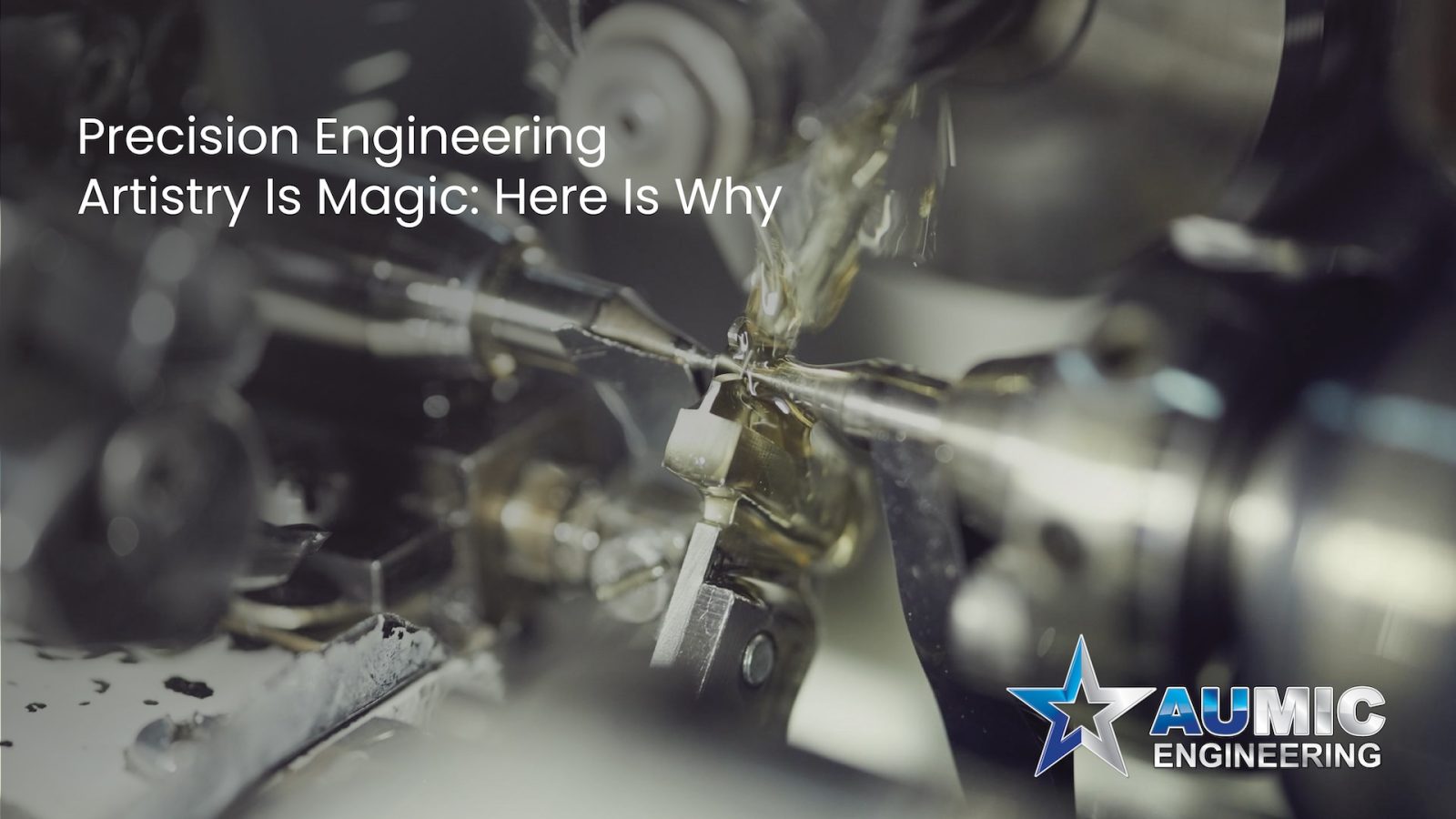In a world driven by meticulous craftsmanship and technical finesse, envision a landscape where even the most intricate designs materialise with unparalleled accuracy. This is the realm of precision engineering artistry, a cornerstone of modern industry and innovation. Precision engineering is not just about exactitude, it is the systematic application of scientific principles to create components and systems with utmost accuracy and reliability.
In this article, we embark on a journey into precision engineering, where precision is not merely a goal but a standard. We will explore the intricacies of this discipline, its pivotal role across diverse sectors, and why it stands as a testament to human ingenuity.
Join us at Aumic Engineering as we uncover the fascinating blend of artistry and technical precision that defines this field and discover why precision engineering holds a place of reverence akin to magic in technology and manufacturing.

Understanding Precision Engineering Artistry
What Is Precision Engineering Artistry And Its Role?
Precision engineering artistry is when you apply scientific principles and advanced techniques to design, manufacture, and assemble intricate components and systems with exceptional accuracy and reliability.
Its role spans different industries, including aerospace, automotive, electronics, healthcare, and more. Precision engineering artistry ensures optimal performance, safety, and efficiency in every sector.
Intricate Processes
The processes involved in precision engineering are highly detailed and exacting. They encompass activities, including computer-aided design (CAD), computer numerical control (CNC) machining, laser cutting, microfabrication, and precision assembly. These processes require meticulous attention to detail, sophisticated equipment, and skilled craftsmanship to achieve the desired precision levels. From micrometre-scale measurements to nanoscale tolerances, every step in precision engineering demands the utmost precision and accuracy.
Importance In Modern Manufacturing And Technology
Precision engineering is the backbone of modern manufacturing and technology. Its significance lies in its ability to deliver components and systems with unparalleled accuracy, consistency, and performance.
When reliability and precision are paramount, such as aerospace and medical device manufacturing, precision engineering ensures compliance with stringent quality standards and regulatory requirements. Moreover, precision engineering drives innovation by enabling the development of innovative technologies, from high-performance microelectronics to advanced medical devices.
In an era defined by rapid technological advancements, the role of precision engineering in shaping the future of manufacturing and technology cannot be overstated.
The Artistry Behind Precision Engineering
Creativity And Skill
Precision engineering artistry is not merely a mechanical process but a creative endeavour that requires a unique blend of creativity and skill. It demands the ability to conceptualise intricate designs and transform them into tangible realities with attention to detail.
From envisioning innovative solutions to overcoming complex challenges, precision engineers rely on their creativity to push the boundaries of what is possible.

Blending Technical Expertise With Artistic Vision
Precision engineers are akin to artisans, infusing technical expertise with artistic vision to create precision engineering. They leverage their deep understanding of materials, manufacturing processes, and technologies to bring designs to life with precision and elegance.
Like master craftsmen, they carefully refine their work, balancing form and function to achieve optimal performance and aesthetic appeal.
Examples Of Precision Engineering Artistry
The realm of precision engineering is replete with examples that exemplify its status as artistry in action. From the sleek contours of a luxury automobile to the intricate mechanisms of a precision timepiece, every masterpiece is a testament to the fusion of technical precision and artistic expression.
Take, for instance, the design of a high-performance aircraft wing, where aerodynamics meet aesthetics to achieve optimal lift and efficiency. Similarly, a modern medical device requires precision engineering and an understanding of human physiology and ergonomic design principles. In each case, precision engineering transcends mere functionality to become a form of artistry that inspires awe and admiration.
The Magic Of Precision Engineering
Miraculous Feats
Precision engineering artistry often accomplishes seemingly miraculous feats that defy conventional wisdom. From the delicate intricacies of microelectronics to the colossal structures of modern architecture, precision engineering enables the realisation of ambitious designs with unparalleled accuracy and reliability.
Whether it is the construction of skyscrapers that withstand the forces of nature or the development of miniature medical devices that save lives, precision engineering continually pushes the boundaries of what is achievable, often leaving observers in awe of its capabilities.
Transformation Of Raw Materials
At the heart of precision engineering lies transforming raw materials into masterpieces of craftsmanship. Through advanced manufacturing techniques, such as CNC machining, additive manufacturing, and laser cutting, precision engineers sculpt raw materials into intricately detailed components with micron-level precision.
Every cut, every curve, and every surface finish is crafted to exact specifications, resulting in products that exhibit technical excellence and aesthetic beauty. Whether it is the precision-engineered components of a luxury watch or the flawless surfaces of a high-performance automobile, precision engineering elevates raw materials into works of art.
Real-World Applications
Precision engineering artistry has revolutionised numerous industries, driving innovation and reshaping our lifestyles and work. In aerospace, precision-engineered components enable aircraft to travel faster, safer, and more efficiently.
In healthcare, precision medical devices, such as implantable pacemakers and robotic surgical systems, have transformed the diagnosis and treatment of diseases. In automotive manufacturing, precision engineering has led to the development of electric vehicles with unprecedented levels of performance and efficiency.
Across these and many other sectors, precision engineering has become the cornerstone of progress, driving technological advancements that enhance our quality of life and propel us into the future.

Challenges And Innovations In Precision Engineering Artistry
Obstacles Faced By Precision Engineers
Precision engineering is not without its challenges. Engineers must contend with factors such as material limitations, environmental conditions, and geometric complexities, all of which can impact the accuracy and reliability of the final product.
Moreover, the demand for ever-higher levels of precision often requires overcoming technical barriers and pushing the boundaries of existing technology. Additionally, the global nature of modern manufacturing introduces logistical challenges, such as supply chain disruptions and quality control issues, that must be addressed to ensure consistent and reliable production.
Innovative Solutions And Advancements
Despite these challenges, precision engineers continue to innovate and develop new solutions to overcome obstacles and push the boundaries of what is possible. Advances in materials science, robotics, artificial intelligence, and digital twin technology are revolutionising the field of precision engineering artistry, enabling engineers to achieve levels of accuracy and efficiency previously thought unattainable.
For example, advanced algorithms and machine learning techniques allow for real-time monitoring and adjustment of manufacturing processes, ensuring optimal performance and quality control. Likewise, integrating additive manufacturing techniques, such as 3D printing, opens up new possibilities for complex geometries with unprecedented precision.
Future Of Precision Engineering
The future of precision engineering artistry appears promising, with potential developments on the horizon. Precision engineers will see further advancements in nanotechnology, quantum computing, and biotechnology to unlock new opportunities for innovation and discovery.
Moreover, the increasing demand for sustainable solutions and environmentally friendly manufacturing processes drive research into renewable materials, energy-efficient production methods, and closed-loop systems that minimise waste and maximise resource use. By embracing these trends and leveraging the latest technology, precision engineers can continue to shape the future of manufacturing and engineering, driving progress and innovation in a rapidly evolving world.
As we look to the future, we must recognise and appreciate the magic of precision engineering artistry and its limitless potential to transform our world.
Read More
Discover The Amazing Future Of Manufacturing & Engineering In 2024.

